Roles, Theories, and Environmental Factors: Uber Leadership Report
VerifiedAdded on 2020/10/22
|11
|3226
|269
Report
AI Summary
This report delves into the operational management and leadership strategies of Uber, examining the roles and functions of leaders and managers, with comparisons and similarities highlighted. It explores various leadership theories, including bureaucratic, contingency, and situational leadership, and models their application within Uber's operational context. The report further analyzes the impact of the business environment on operational decision-making, using PESTLE analysis to assess political, economic, social, technological, legal, and environmental factors. The analysis covers how Uber adapts to rapid and slow changes, illustrating the interplay between leadership, management, and external factors in achieving business goals. The report concludes by emphasizing the significance of effective operational management in enhancing efficiency and profitability within the company.
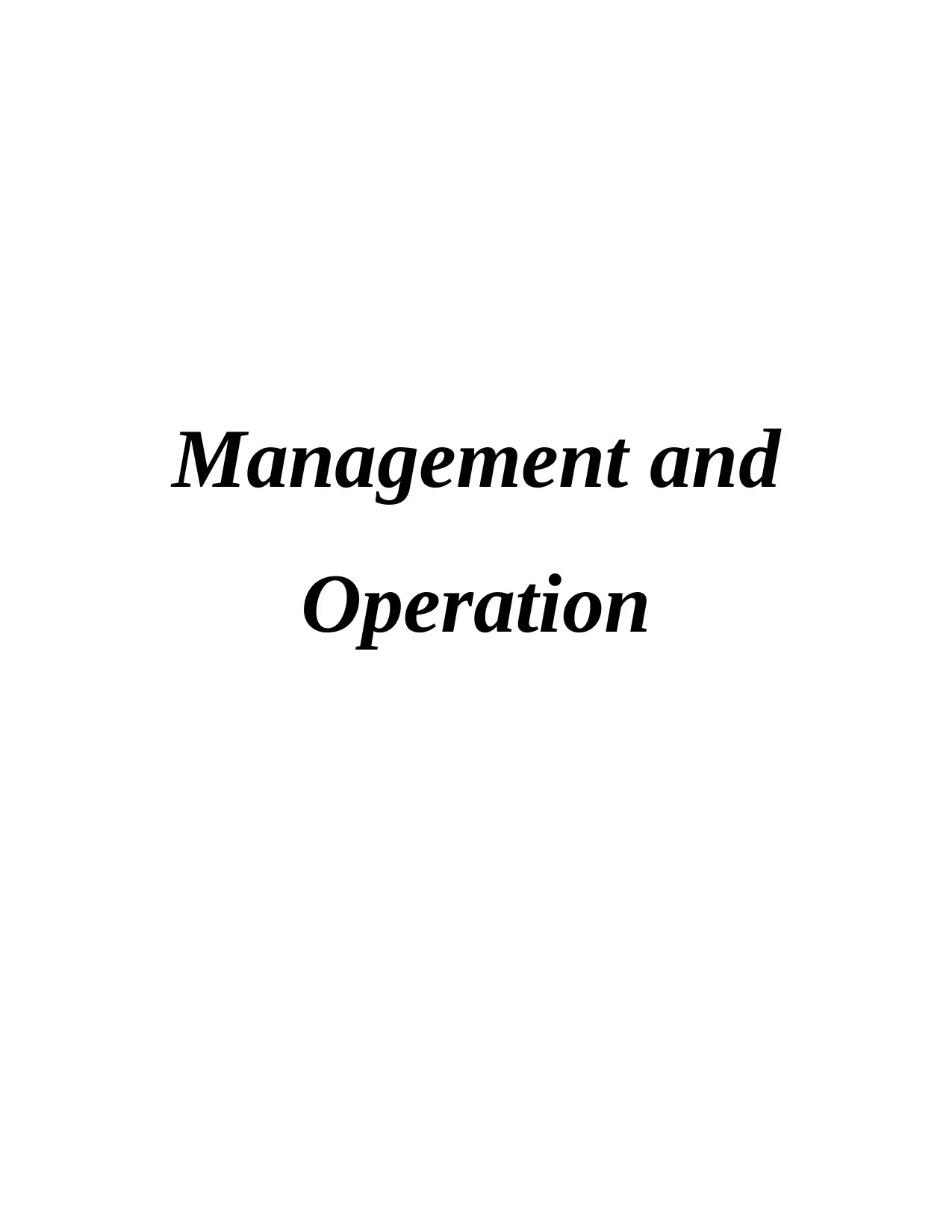
Management and
Operation
Operation
Paraphrase This Document
Need a fresh take? Get an instant paraphrase of this document with our AI Paraphraser
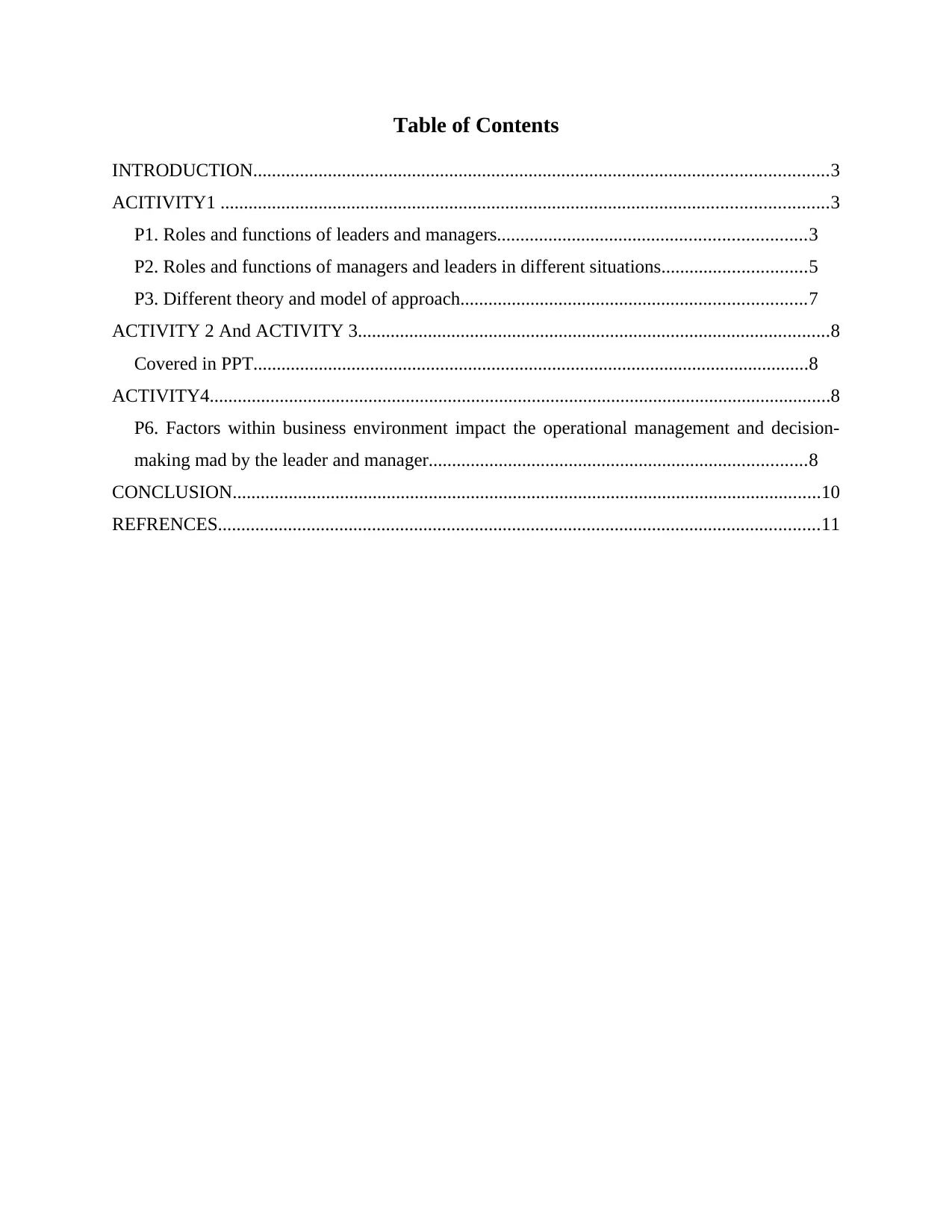
Table of Contents
INTRODUCTION...........................................................................................................................3
ACITIVITY1 ..................................................................................................................................3
P1. Roles and functions of leaders and managers..................................................................3
P2. Roles and functions of managers and leaders in different situations...............................5
P3. Different theory and model of approach..........................................................................7
ACTIVITY 2 And ACTIVITY 3.....................................................................................................8
Covered in PPT.......................................................................................................................8
ACTIVITY4.....................................................................................................................................8
P6. Factors within business environment impact the operational management and decision-
making mad by the leader and manager.................................................................................8
CONCLUSION..............................................................................................................................10
REFRENCES.................................................................................................................................11
INTRODUCTION...........................................................................................................................3
ACITIVITY1 ..................................................................................................................................3
P1. Roles and functions of leaders and managers..................................................................3
P2. Roles and functions of managers and leaders in different situations...............................5
P3. Different theory and model of approach..........................................................................7
ACTIVITY 2 And ACTIVITY 3.....................................................................................................8
Covered in PPT.......................................................................................................................8
ACTIVITY4.....................................................................................................................................8
P6. Factors within business environment impact the operational management and decision-
making mad by the leader and manager.................................................................................8
CONCLUSION..............................................................................................................................10
REFRENCES.................................................................................................................................11
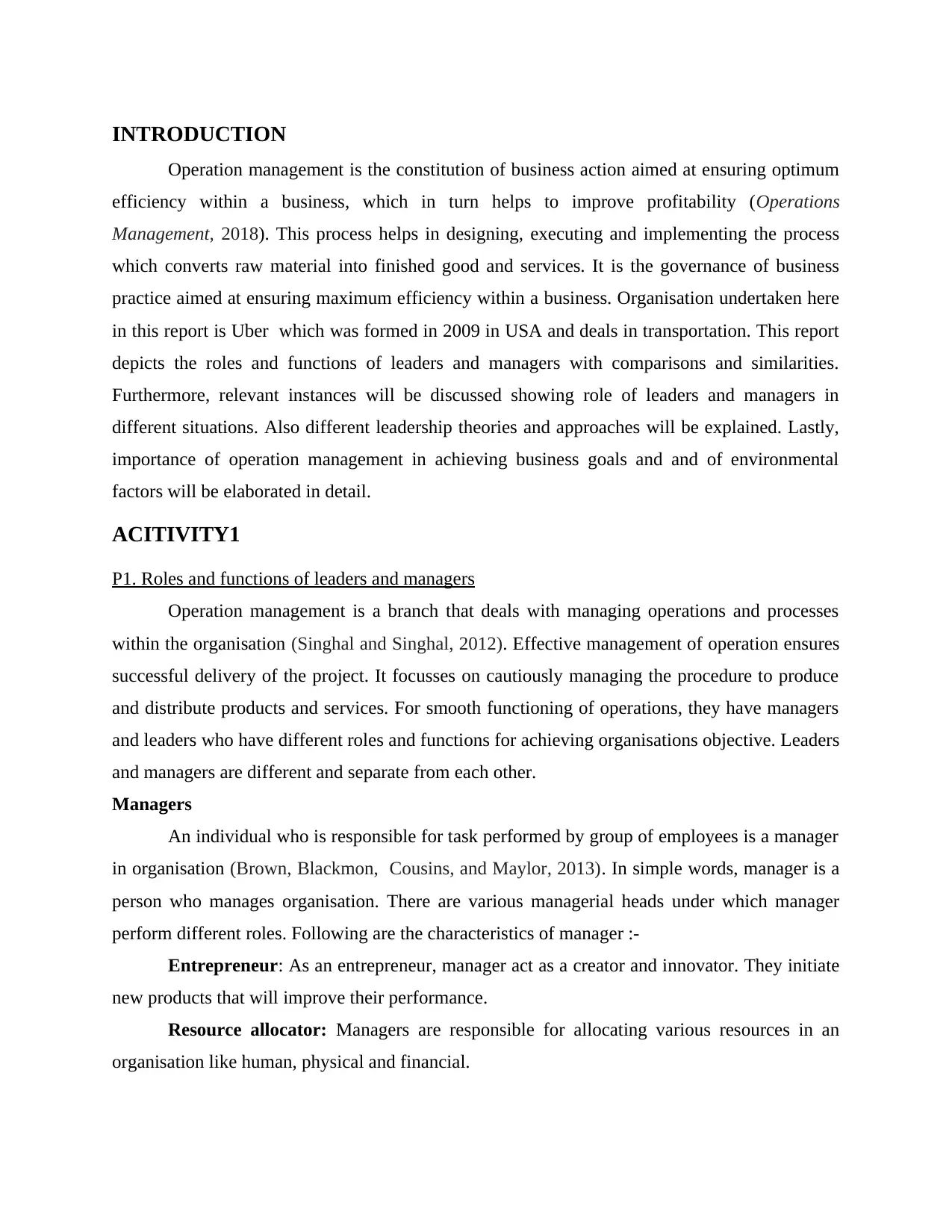
INTRODUCTION
Operation management is the constitution of business action aimed at ensuring optimum
efficiency within a business, which in turn helps to improve profitability (Operations
Management, 2018). This process helps in designing, executing and implementing the process
which converts raw material into finished good and services. It is the governance of business
practice aimed at ensuring maximum efficiency within a business. Organisation undertaken here
in this report is Uber which was formed in 2009 in USA and deals in transportation. This report
depicts the roles and functions of leaders and managers with comparisons and similarities.
Furthermore, relevant instances will be discussed showing role of leaders and managers in
different situations. Also different leadership theories and approaches will be explained. Lastly,
importance of operation management in achieving business goals and and of environmental
factors will be elaborated in detail.
ACITIVITY1
P1. Roles and functions of leaders and managers
Operation management is a branch that deals with managing operations and processes
within the organisation (Singhal and Singhal, 2012). Effective management of operation ensures
successful delivery of the project. It focusses on cautiously managing the procedure to produce
and distribute products and services. For smooth functioning of operations, they have managers
and leaders who have different roles and functions for achieving organisations objective. Leaders
and managers are different and separate from each other.
Managers
An individual who is responsible for task performed by group of employees is a manager
in organisation (Brown, Blackmon, Cousins, and Maylor, 2013). In simple words, manager is a
person who manages organisation. There are various managerial heads under which manager
perform different roles. Following are the characteristics of manager :-
Entrepreneur: As an entrepreneur, manager act as a creator and innovator. They initiate
new products that will improve their performance.
Resource allocator: Managers are responsible for allocating various resources in an
organisation like human, physical and financial.
Operation management is the constitution of business action aimed at ensuring optimum
efficiency within a business, which in turn helps to improve profitability (Operations
Management, 2018). This process helps in designing, executing and implementing the process
which converts raw material into finished good and services. It is the governance of business
practice aimed at ensuring maximum efficiency within a business. Organisation undertaken here
in this report is Uber which was formed in 2009 in USA and deals in transportation. This report
depicts the roles and functions of leaders and managers with comparisons and similarities.
Furthermore, relevant instances will be discussed showing role of leaders and managers in
different situations. Also different leadership theories and approaches will be explained. Lastly,
importance of operation management in achieving business goals and and of environmental
factors will be elaborated in detail.
ACITIVITY1
P1. Roles and functions of leaders and managers
Operation management is a branch that deals with managing operations and processes
within the organisation (Singhal and Singhal, 2012). Effective management of operation ensures
successful delivery of the project. It focusses on cautiously managing the procedure to produce
and distribute products and services. For smooth functioning of operations, they have managers
and leaders who have different roles and functions for achieving organisations objective. Leaders
and managers are different and separate from each other.
Managers
An individual who is responsible for task performed by group of employees is a manager
in organisation (Brown, Blackmon, Cousins, and Maylor, 2013). In simple words, manager is a
person who manages organisation. There are various managerial heads under which manager
perform different roles. Following are the characteristics of manager :-
Entrepreneur: As an entrepreneur, manager act as a creator and innovator. They initiate
new products that will improve their performance.
Resource allocator: Managers are responsible for allocating various resources in an
organisation like human, physical and financial.
⊘ This is a preview!⊘
Do you want full access?
Subscribe today to unlock all pages.

Trusted by 1+ million students worldwide
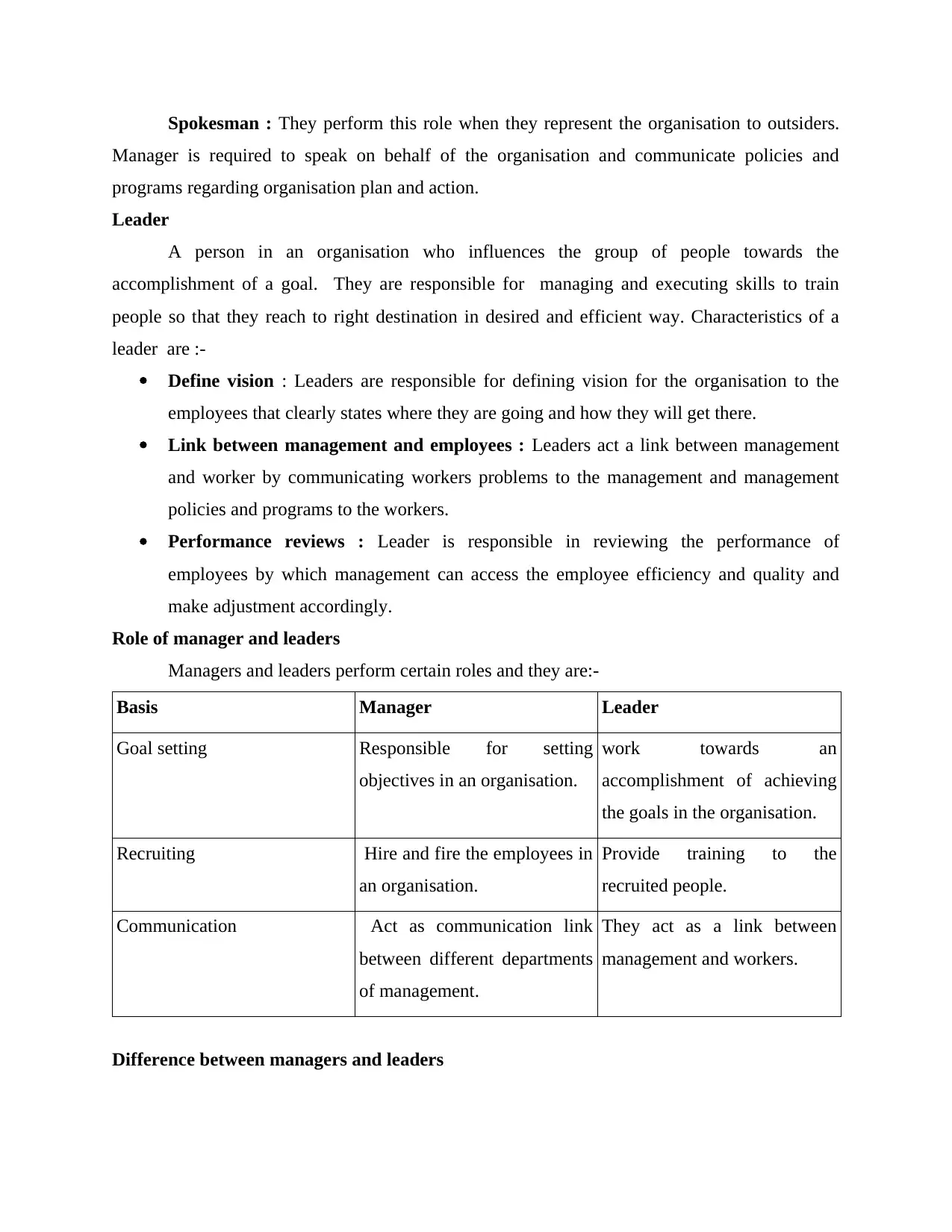
Spokesman : They perform this role when they represent the organisation to outsiders.
Manager is required to speak on behalf of the organisation and communicate policies and
programs regarding organisation plan and action.
Leader
A person in an organisation who influences the group of people towards the
accomplishment of a goal. They are responsible for managing and executing skills to train
people so that they reach to right destination in desired and efficient way. Characteristics of a
leader are :-
Define vision : Leaders are responsible for defining vision for the organisation to the
employees that clearly states where they are going and how they will get there.
Link between management and employees : Leaders act a link between management
and worker by communicating workers problems to the management and management
policies and programs to the workers.
Performance reviews : Leader is responsible in reviewing the performance of
employees by which management can access the employee efficiency and quality and
make adjustment accordingly.
Role of manager and leaders
Managers and leaders perform certain roles and they are:-
Basis Manager Leader
Goal setting Responsible for setting
objectives in an organisation.
work towards an
accomplishment of achieving
the goals in the organisation.
Recruiting Hire and fire the employees in
an organisation.
Provide training to the
recruited people.
Communication Act as communication link
between different departments
of management.
They act as a link between
management and workers.
Difference between managers and leaders
Manager is required to speak on behalf of the organisation and communicate policies and
programs regarding organisation plan and action.
Leader
A person in an organisation who influences the group of people towards the
accomplishment of a goal. They are responsible for managing and executing skills to train
people so that they reach to right destination in desired and efficient way. Characteristics of a
leader are :-
Define vision : Leaders are responsible for defining vision for the organisation to the
employees that clearly states where they are going and how they will get there.
Link between management and employees : Leaders act a link between management
and worker by communicating workers problems to the management and management
policies and programs to the workers.
Performance reviews : Leader is responsible in reviewing the performance of
employees by which management can access the employee efficiency and quality and
make adjustment accordingly.
Role of manager and leaders
Managers and leaders perform certain roles and they are:-
Basis Manager Leader
Goal setting Responsible for setting
objectives in an organisation.
work towards an
accomplishment of achieving
the goals in the organisation.
Recruiting Hire and fire the employees in
an organisation.
Provide training to the
recruited people.
Communication Act as communication link
between different departments
of management.
They act as a link between
management and workers.
Difference between managers and leaders
Paraphrase This Document
Need a fresh take? Get an instant paraphrase of this document with our AI Paraphraser
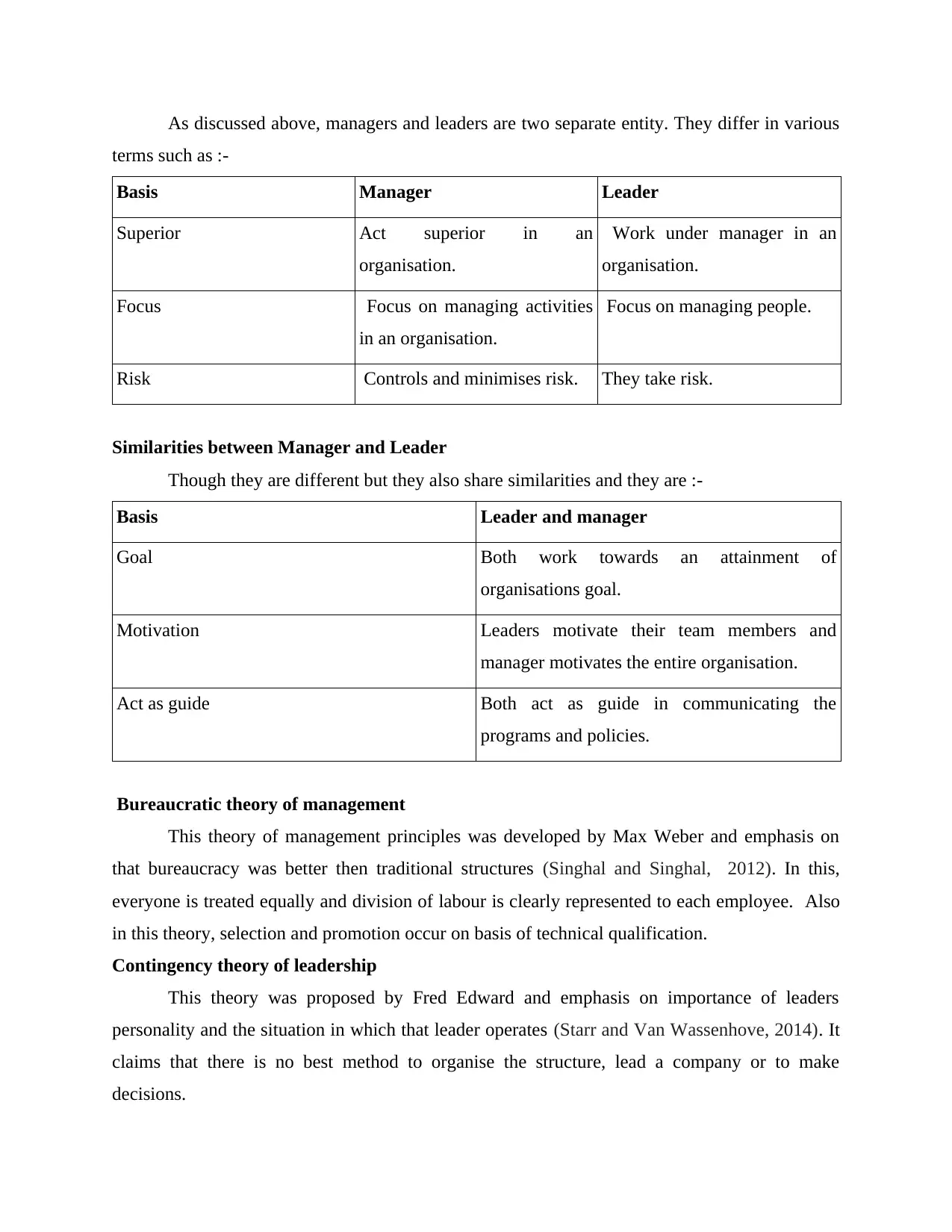
As discussed above, managers and leaders are two separate entity. They differ in various
terms such as :-
Basis Manager Leader
Superior Act superior in an
organisation.
Work under manager in an
organisation.
Focus Focus on managing activities
in an organisation.
Focus on managing people.
Risk Controls and minimises risk. They take risk.
Similarities between Manager and Leader
Though they are different but they also share similarities and they are :-
Basis Leader and manager
Goal Both work towards an attainment of
organisations goal.
Motivation Leaders motivate their team members and
manager motivates the entire organisation.
Act as guide Both act as guide in communicating the
programs and policies.
Bureaucratic theory of management
This theory of management principles was developed by Max Weber and emphasis on
that bureaucracy was better then traditional structures (Singhal and Singhal, 2012). In this,
everyone is treated equally and division of labour is clearly represented to each employee. Also
in this theory, selection and promotion occur on basis of technical qualification.
Contingency theory of leadership
This theory was proposed by Fred Edward and emphasis on importance of leaders
personality and the situation in which that leader operates (Starr and Van Wassenhove, 2014). It
claims that there is no best method to organise the structure, lead a company or to make
decisions.
terms such as :-
Basis Manager Leader
Superior Act superior in an
organisation.
Work under manager in an
organisation.
Focus Focus on managing activities
in an organisation.
Focus on managing people.
Risk Controls and minimises risk. They take risk.
Similarities between Manager and Leader
Though they are different but they also share similarities and they are :-
Basis Leader and manager
Goal Both work towards an attainment of
organisations goal.
Motivation Leaders motivate their team members and
manager motivates the entire organisation.
Act as guide Both act as guide in communicating the
programs and policies.
Bureaucratic theory of management
This theory of management principles was developed by Max Weber and emphasis on
that bureaucracy was better then traditional structures (Singhal and Singhal, 2012). In this,
everyone is treated equally and division of labour is clearly represented to each employee. Also
in this theory, selection and promotion occur on basis of technical qualification.
Contingency theory of leadership
This theory was proposed by Fred Edward and emphasis on importance of leaders
personality and the situation in which that leader operates (Starr and Van Wassenhove, 2014). It
claims that there is no best method to organise the structure, lead a company or to make
decisions.
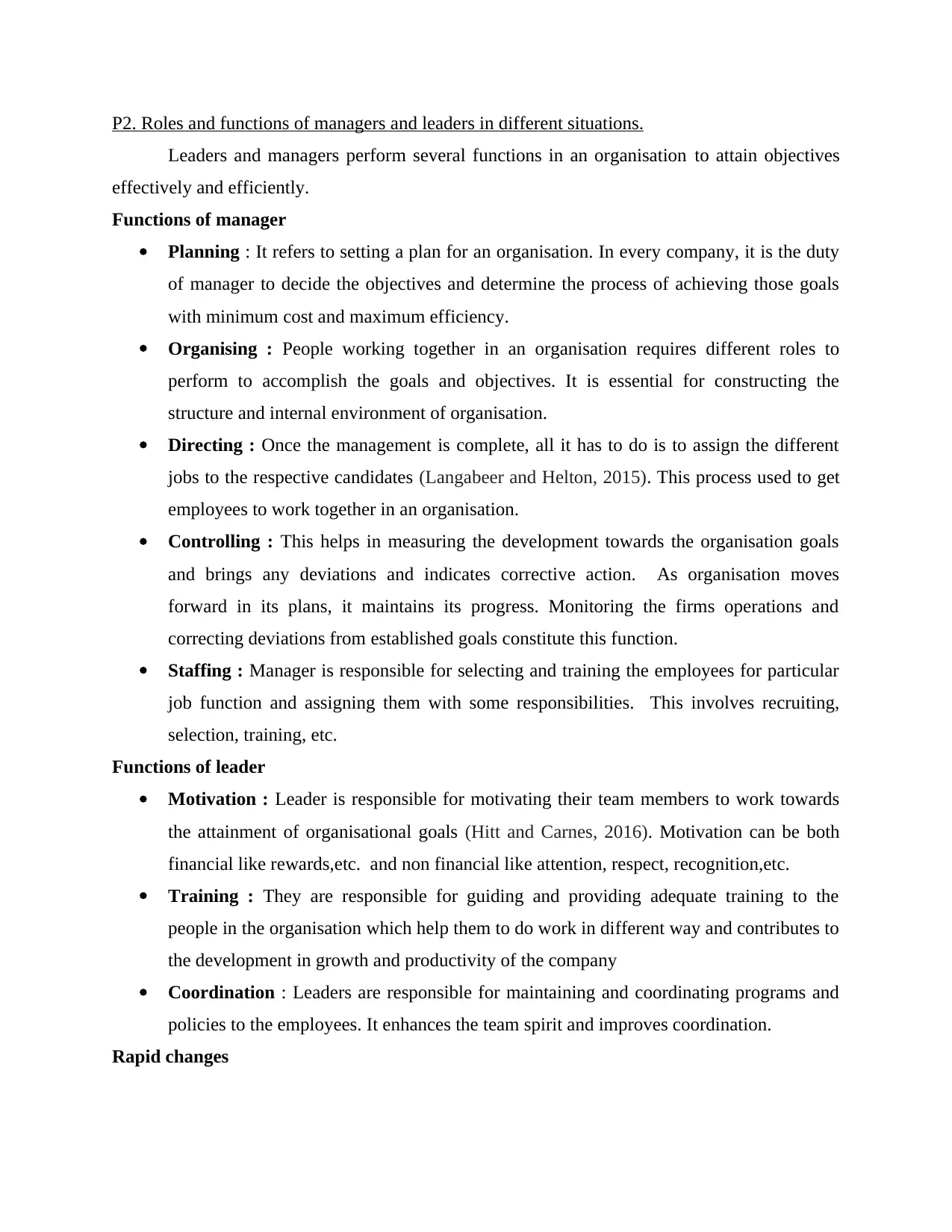
P2. Roles and functions of managers and leaders in different situations.
Leaders and managers perform several functions in an organisation to attain objectives
effectively and efficiently.
Functions of manager
Planning : It refers to setting a plan for an organisation. In every company, it is the duty
of manager to decide the objectives and determine the process of achieving those goals
with minimum cost and maximum efficiency.
Organising : People working together in an organisation requires different roles to
perform to accomplish the goals and objectives. It is essential for constructing the
structure and internal environment of organisation.
Directing : Once the management is complete, all it has to do is to assign the different
jobs to the respective candidates (Langabeer and Helton, 2015). This process used to get
employees to work together in an organisation.
Controlling : This helps in measuring the development towards the organisation goals
and brings any deviations and indicates corrective action. As organisation moves
forward in its plans, it maintains its progress. Monitoring the firms operations and
correcting deviations from established goals constitute this function.
Staffing : Manager is responsible for selecting and training the employees for particular
job function and assigning them with some responsibilities. This involves recruiting,
selection, training, etc.
Functions of leader
Motivation : Leader is responsible for motivating their team members to work towards
the attainment of organisational goals (Hitt and Carnes, 2016). Motivation can be both
financial like rewards,etc. and non financial like attention, respect, recognition,etc.
Training : They are responsible for guiding and providing adequate training to the
people in the organisation which help them to do work in different way and contributes to
the development in growth and productivity of the company
Coordination : Leaders are responsible for maintaining and coordinating programs and
policies to the employees. It enhances the team spirit and improves coordination.
Rapid changes
Leaders and managers perform several functions in an organisation to attain objectives
effectively and efficiently.
Functions of manager
Planning : It refers to setting a plan for an organisation. In every company, it is the duty
of manager to decide the objectives and determine the process of achieving those goals
with minimum cost and maximum efficiency.
Organising : People working together in an organisation requires different roles to
perform to accomplish the goals and objectives. It is essential for constructing the
structure and internal environment of organisation.
Directing : Once the management is complete, all it has to do is to assign the different
jobs to the respective candidates (Langabeer and Helton, 2015). This process used to get
employees to work together in an organisation.
Controlling : This helps in measuring the development towards the organisation goals
and brings any deviations and indicates corrective action. As organisation moves
forward in its plans, it maintains its progress. Monitoring the firms operations and
correcting deviations from established goals constitute this function.
Staffing : Manager is responsible for selecting and training the employees for particular
job function and assigning them with some responsibilities. This involves recruiting,
selection, training, etc.
Functions of leader
Motivation : Leader is responsible for motivating their team members to work towards
the attainment of organisational goals (Hitt and Carnes, 2016). Motivation can be both
financial like rewards,etc. and non financial like attention, respect, recognition,etc.
Training : They are responsible for guiding and providing adequate training to the
people in the organisation which help them to do work in different way and contributes to
the development in growth and productivity of the company
Coordination : Leaders are responsible for maintaining and coordinating programs and
policies to the employees. It enhances the team spirit and improves coordination.
Rapid changes
⊘ This is a preview!⊘
Do you want full access?
Subscribe today to unlock all pages.

Trusted by 1+ million students worldwide
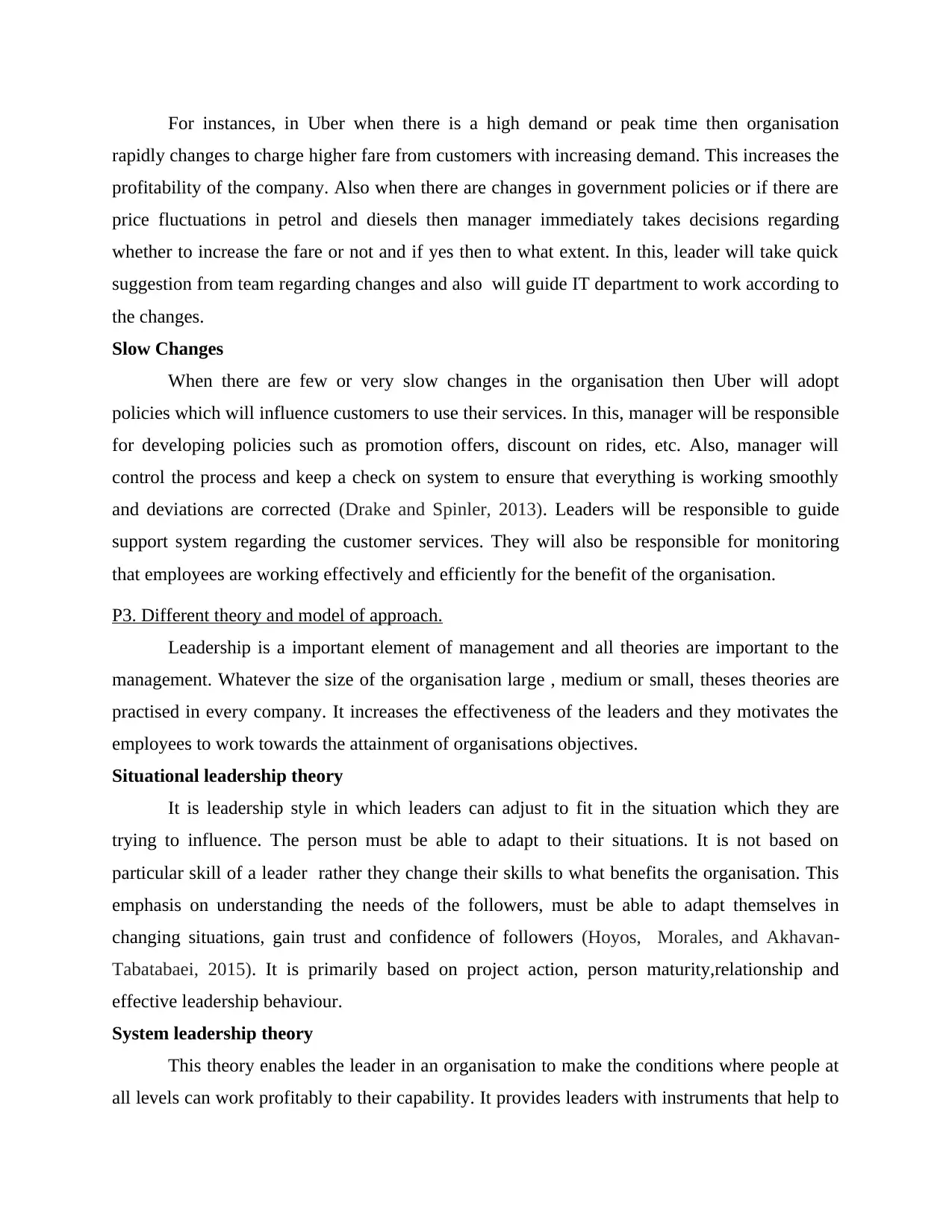
For instances, in Uber when there is a high demand or peak time then organisation
rapidly changes to charge higher fare from customers with increasing demand. This increases the
profitability of the company. Also when there are changes in government policies or if there are
price fluctuations in petrol and diesels then manager immediately takes decisions regarding
whether to increase the fare or not and if yes then to what extent. In this, leader will take quick
suggestion from team regarding changes and also will guide IT department to work according to
the changes.
Slow Changes
When there are few or very slow changes in the organisation then Uber will adopt
policies which will influence customers to use their services. In this, manager will be responsible
for developing policies such as promotion offers, discount on rides, etc. Also, manager will
control the process and keep a check on system to ensure that everything is working smoothly
and deviations are corrected (Drake and Spinler, 2013). Leaders will be responsible to guide
support system regarding the customer services. They will also be responsible for monitoring
that employees are working effectively and efficiently for the benefit of the organisation.
P3. Different theory and model of approach.
Leadership is a important element of management and all theories are important to the
management. Whatever the size of the organisation large , medium or small, theses theories are
practised in every company. It increases the effectiveness of the leaders and they motivates the
employees to work towards the attainment of organisations objectives.
Situational leadership theory
It is leadership style in which leaders can adjust to fit in the situation which they are
trying to influence. The person must be able to adapt to their situations. It is not based on
particular skill of a leader rather they change their skills to what benefits the organisation. This
emphasis on understanding the needs of the followers, must be able to adapt themselves in
changing situations, gain trust and confidence of followers (Hoyos, Morales, and Akhavan-
Tabatabaei, 2015). It is primarily based on project action, person maturity,relationship and
effective leadership behaviour.
System leadership theory
This theory enables the leader in an organisation to make the conditions where people at
all levels can work profitably to their capability. It provides leaders with instruments that help to
rapidly changes to charge higher fare from customers with increasing demand. This increases the
profitability of the company. Also when there are changes in government policies or if there are
price fluctuations in petrol and diesels then manager immediately takes decisions regarding
whether to increase the fare or not and if yes then to what extent. In this, leader will take quick
suggestion from team regarding changes and also will guide IT department to work according to
the changes.
Slow Changes
When there are few or very slow changes in the organisation then Uber will adopt
policies which will influence customers to use their services. In this, manager will be responsible
for developing policies such as promotion offers, discount on rides, etc. Also, manager will
control the process and keep a check on system to ensure that everything is working smoothly
and deviations are corrected (Drake and Spinler, 2013). Leaders will be responsible to guide
support system regarding the customer services. They will also be responsible for monitoring
that employees are working effectively and efficiently for the benefit of the organisation.
P3. Different theory and model of approach.
Leadership is a important element of management and all theories are important to the
management. Whatever the size of the organisation large , medium or small, theses theories are
practised in every company. It increases the effectiveness of the leaders and they motivates the
employees to work towards the attainment of organisations objectives.
Situational leadership theory
It is leadership style in which leaders can adjust to fit in the situation which they are
trying to influence. The person must be able to adapt to their situations. It is not based on
particular skill of a leader rather they change their skills to what benefits the organisation. This
emphasis on understanding the needs of the followers, must be able to adapt themselves in
changing situations, gain trust and confidence of followers (Hoyos, Morales, and Akhavan-
Tabatabaei, 2015). It is primarily based on project action, person maturity,relationship and
effective leadership behaviour.
System leadership theory
This theory enables the leader in an organisation to make the conditions where people at
all levels can work profitably to their capability. It provides leaders with instruments that help to
Paraphrase This Document
Need a fresh take? Get an instant paraphrase of this document with our AI Paraphraser
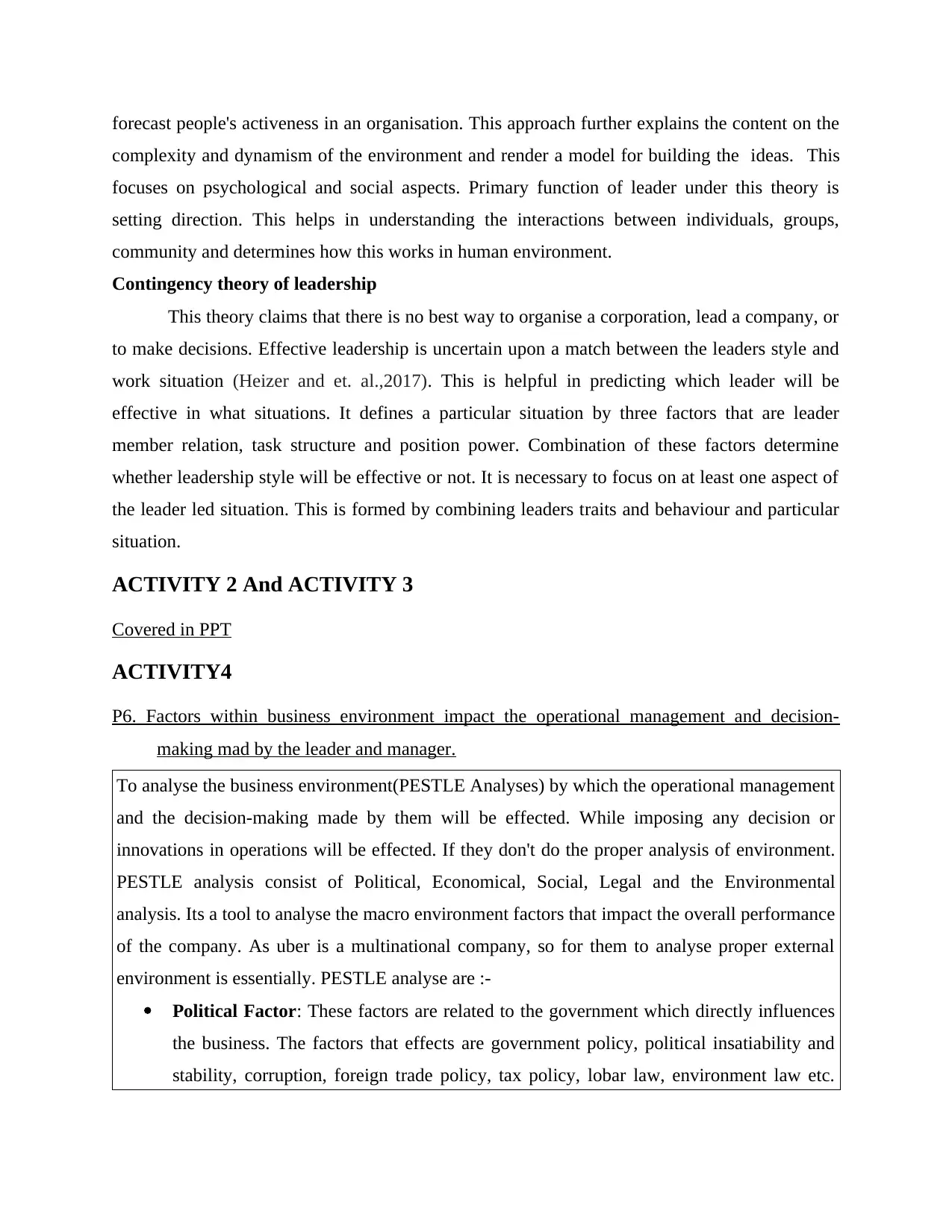
forecast people's activeness in an organisation. This approach further explains the content on the
complexity and dynamism of the environment and render a model for building the ideas. This
focuses on psychological and social aspects. Primary function of leader under this theory is
setting direction. This helps in understanding the interactions between individuals, groups,
community and determines how this works in human environment.
Contingency theory of leadership
This theory claims that there is no best way to organise a corporation, lead a company, or
to make decisions. Effective leadership is uncertain upon a match between the leaders style and
work situation (Heizer and et. al.,2017). This is helpful in predicting which leader will be
effective in what situations. It defines a particular situation by three factors that are leader
member relation, task structure and position power. Combination of these factors determine
whether leadership style will be effective or not. It is necessary to focus on at least one aspect of
the leader led situation. This is formed by combining leaders traits and behaviour and particular
situation.
ACTIVITY 2 And ACTIVITY 3
Covered in PPT
ACTIVITY4
P6. Factors within business environment impact the operational management and decision-
making mad by the leader and manager.
To analyse the business environment(PESTLE Analyses) by which the operational management
and the decision-making made by them will be effected. While imposing any decision or
innovations in operations will be effected. If they don't do the proper analysis of environment.
PESTLE analysis consist of Political, Economical, Social, Legal and the Environmental
analysis. Its a tool to analyse the macro environment factors that impact the overall performance
of the company. As uber is a multinational company, so for them to analyse proper external
environment is essentially. PESTLE analyse are :-
Political Factor: These factors are related to the government which directly influences
the business. The factors that effects are government policy, political insatiability and
stability, corruption, foreign trade policy, tax policy, lobar law, environment law etc.
complexity and dynamism of the environment and render a model for building the ideas. This
focuses on psychological and social aspects. Primary function of leader under this theory is
setting direction. This helps in understanding the interactions between individuals, groups,
community and determines how this works in human environment.
Contingency theory of leadership
This theory claims that there is no best way to organise a corporation, lead a company, or
to make decisions. Effective leadership is uncertain upon a match between the leaders style and
work situation (Heizer and et. al.,2017). This is helpful in predicting which leader will be
effective in what situations. It defines a particular situation by three factors that are leader
member relation, task structure and position power. Combination of these factors determine
whether leadership style will be effective or not. It is necessary to focus on at least one aspect of
the leader led situation. This is formed by combining leaders traits and behaviour and particular
situation.
ACTIVITY 2 And ACTIVITY 3
Covered in PPT
ACTIVITY4
P6. Factors within business environment impact the operational management and decision-
making mad by the leader and manager.
To analyse the business environment(PESTLE Analyses) by which the operational management
and the decision-making made by them will be effected. While imposing any decision or
innovations in operations will be effected. If they don't do the proper analysis of environment.
PESTLE analysis consist of Political, Economical, Social, Legal and the Environmental
analysis. Its a tool to analyse the macro environment factors that impact the overall performance
of the company. As uber is a multinational company, so for them to analyse proper external
environment is essentially. PESTLE analyse are :-
Political Factor: These factors are related to the government which directly influences
the business. The factors that effects are government policy, political insatiability and
stability, corruption, foreign trade policy, tax policy, lobar law, environment law etc.
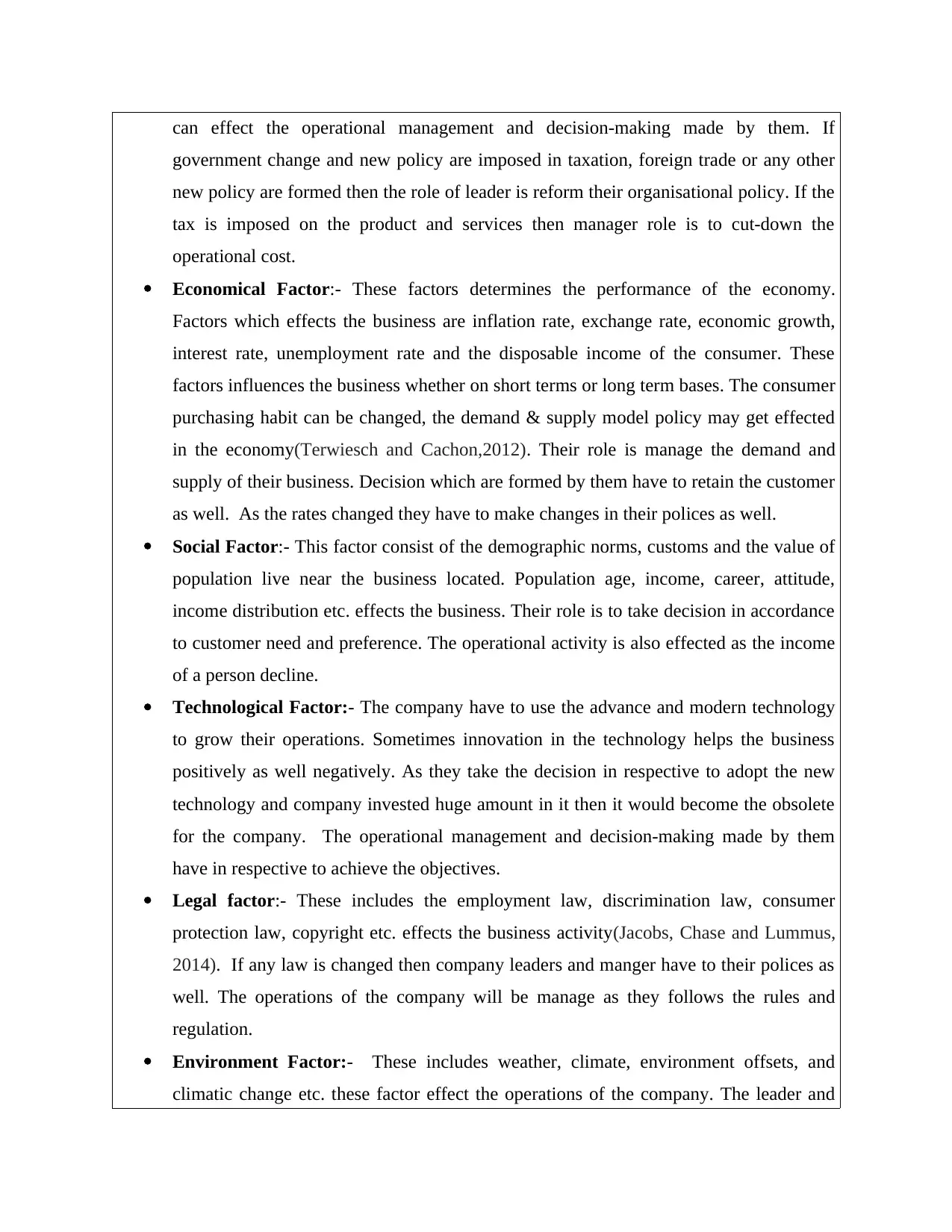
can effect the operational management and decision-making made by them. If
government change and new policy are imposed in taxation, foreign trade or any other
new policy are formed then the role of leader is reform their organisational policy. If the
tax is imposed on the product and services then manager role is to cut-down the
operational cost.
Economical Factor:- These factors determines the performance of the economy.
Factors which effects the business are inflation rate, exchange rate, economic growth,
interest rate, unemployment rate and the disposable income of the consumer. These
factors influences the business whether on short terms or long term bases. The consumer
purchasing habit can be changed, the demand & supply model policy may get effected
in the economy(Terwiesch and Cachon,2012). Their role is manage the demand and
supply of their business. Decision which are formed by them have to retain the customer
as well. As the rates changed they have to make changes in their polices as well.
Social Factor:- This factor consist of the demographic norms, customs and the value of
population live near the business located. Population age, income, career, attitude,
income distribution etc. effects the business. Their role is to take decision in accordance
to customer need and preference. The operational activity is also effected as the income
of a person decline.
Technological Factor:- The company have to use the advance and modern technology
to grow their operations. Sometimes innovation in the technology helps the business
positively as well negatively. As they take the decision in respective to adopt the new
technology and company invested huge amount in it then it would become the obsolete
for the company. The operational management and decision-making made by them
have in respective to achieve the objectives.
Legal factor:- These includes the employment law, discrimination law, consumer
protection law, copyright etc. effects the business activity(Jacobs, Chase and Lummus,
2014). If any law is changed then company leaders and manger have to their polices as
well. The operations of the company will be manage as they follows the rules and
regulation.
Environment Factor:- These includes weather, climate, environment offsets, and
climatic change etc. these factor effect the operations of the company. The leader and
government change and new policy are imposed in taxation, foreign trade or any other
new policy are formed then the role of leader is reform their organisational policy. If the
tax is imposed on the product and services then manager role is to cut-down the
operational cost.
Economical Factor:- These factors determines the performance of the economy.
Factors which effects the business are inflation rate, exchange rate, economic growth,
interest rate, unemployment rate and the disposable income of the consumer. These
factors influences the business whether on short terms or long term bases. The consumer
purchasing habit can be changed, the demand & supply model policy may get effected
in the economy(Terwiesch and Cachon,2012). Their role is manage the demand and
supply of their business. Decision which are formed by them have to retain the customer
as well. As the rates changed they have to make changes in their polices as well.
Social Factor:- This factor consist of the demographic norms, customs and the value of
population live near the business located. Population age, income, career, attitude,
income distribution etc. effects the business. Their role is to take decision in accordance
to customer need and preference. The operational activity is also effected as the income
of a person decline.
Technological Factor:- The company have to use the advance and modern technology
to grow their operations. Sometimes innovation in the technology helps the business
positively as well negatively. As they take the decision in respective to adopt the new
technology and company invested huge amount in it then it would become the obsolete
for the company. The operational management and decision-making made by them
have in respective to achieve the objectives.
Legal factor:- These includes the employment law, discrimination law, consumer
protection law, copyright etc. effects the business activity(Jacobs, Chase and Lummus,
2014). If any law is changed then company leaders and manger have to their polices as
well. The operations of the company will be manage as they follows the rules and
regulation.
Environment Factor:- These includes weather, climate, environment offsets, and
climatic change etc. these factor effect the operations of the company. The leader and
⊘ This is a preview!⊘
Do you want full access?
Subscribe today to unlock all pages.

Trusted by 1+ million students worldwide
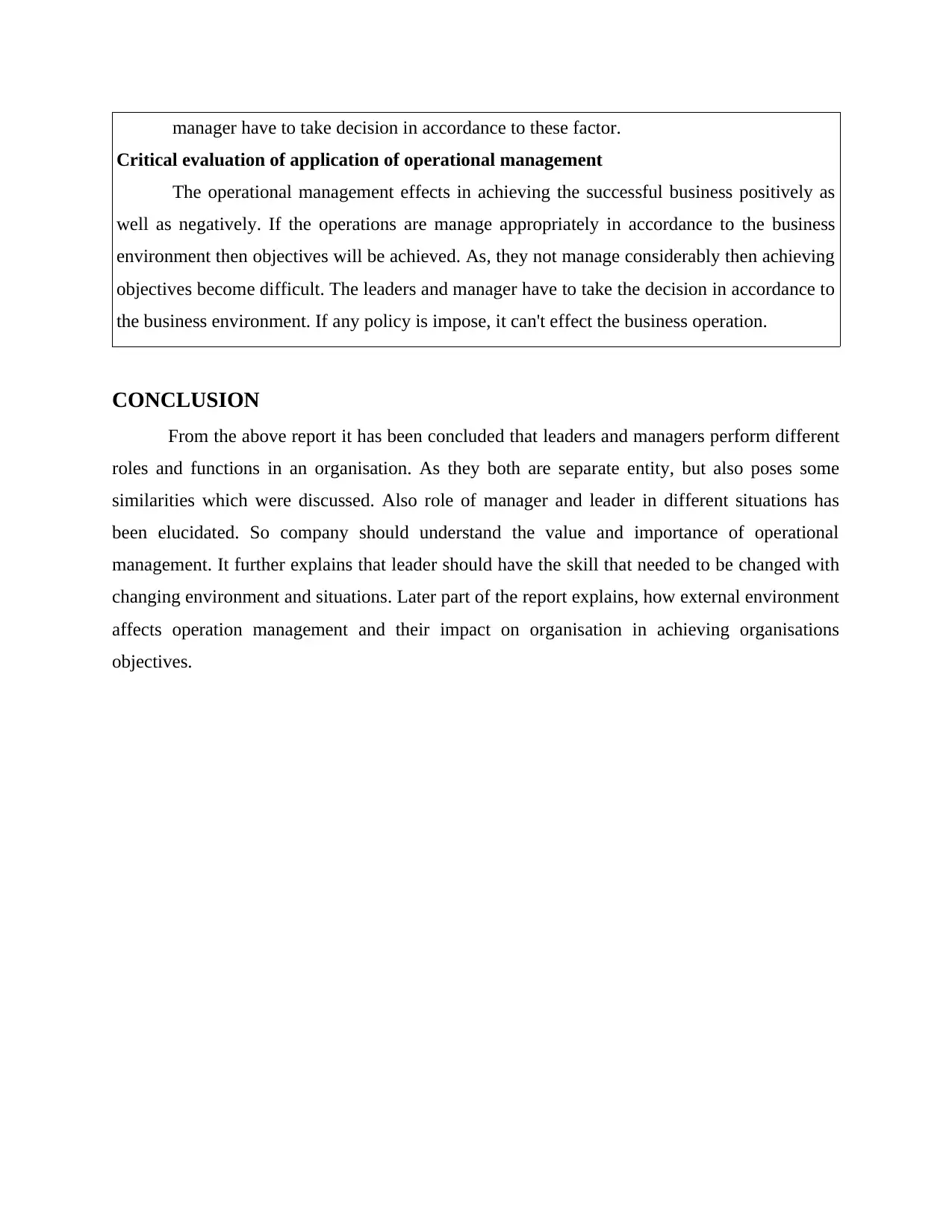
manager have to take decision in accordance to these factor.
Critical evaluation of application of operational management
The operational management effects in achieving the successful business positively as
well as negatively. If the operations are manage appropriately in accordance to the business
environment then objectives will be achieved. As, they not manage considerably then achieving
objectives become difficult. The leaders and manager have to take the decision in accordance to
the business environment. If any policy is impose, it can't effect the business operation.
CONCLUSION
From the above report it has been concluded that leaders and managers perform different
roles and functions in an organisation. As they both are separate entity, but also poses some
similarities which were discussed. Also role of manager and leader in different situations has
been elucidated. So company should understand the value and importance of operational
management. It further explains that leader should have the skill that needed to be changed with
changing environment and situations. Later part of the report explains, how external environment
affects operation management and their impact on organisation in achieving organisations
objectives.
Critical evaluation of application of operational management
The operational management effects in achieving the successful business positively as
well as negatively. If the operations are manage appropriately in accordance to the business
environment then objectives will be achieved. As, they not manage considerably then achieving
objectives become difficult. The leaders and manager have to take the decision in accordance to
the business environment. If any policy is impose, it can't effect the business operation.
CONCLUSION
From the above report it has been concluded that leaders and managers perform different
roles and functions in an organisation. As they both are separate entity, but also poses some
similarities which were discussed. Also role of manager and leader in different situations has
been elucidated. So company should understand the value and importance of operational
management. It further explains that leader should have the skill that needed to be changed with
changing environment and situations. Later part of the report explains, how external environment
affects operation management and their impact on organisation in achieving organisations
objectives.
Paraphrase This Document
Need a fresh take? Get an instant paraphrase of this document with our AI Paraphraser
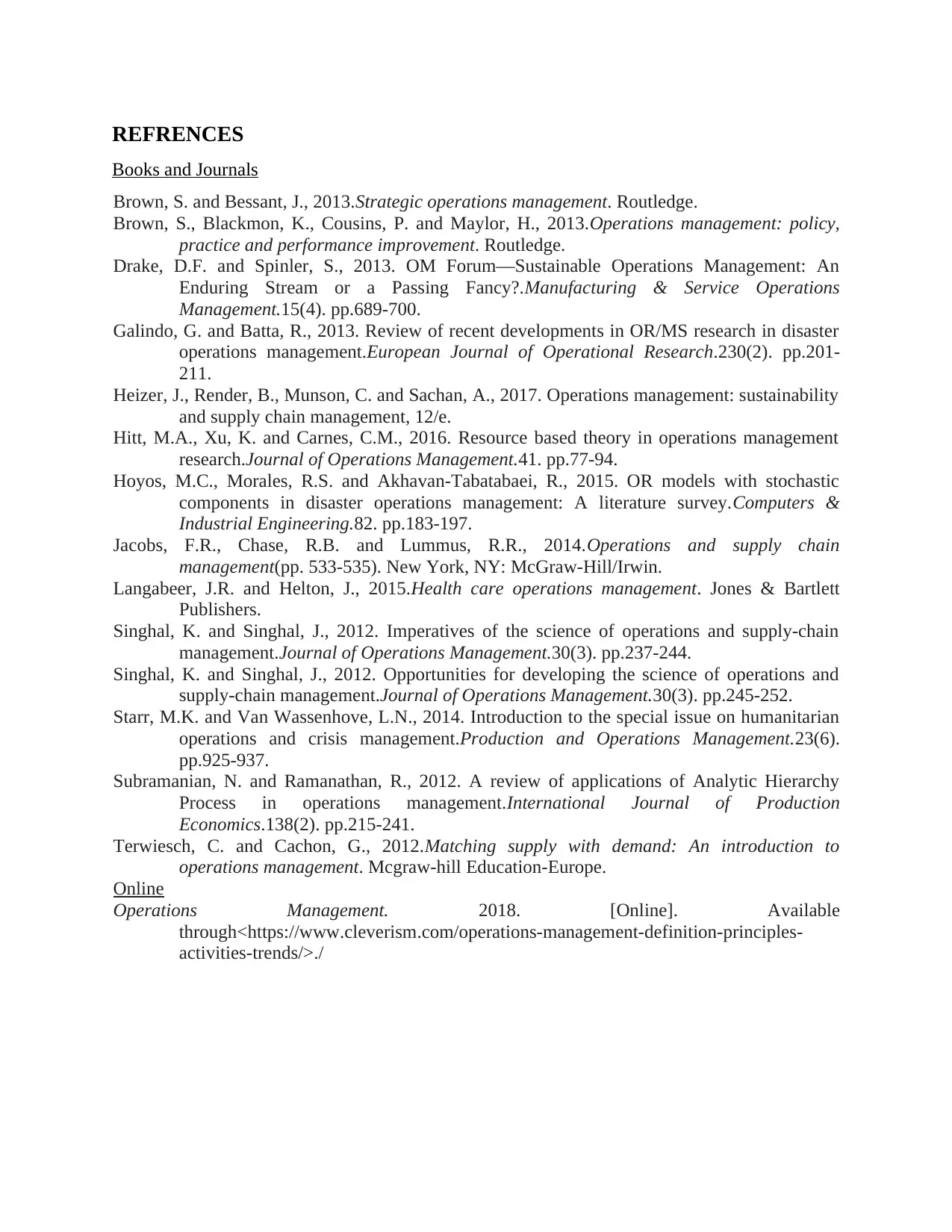
REFRENCES
Books and Journals
Brown, S. and Bessant, J., 2013.Strategic operations management. Routledge.
Brown, S., Blackmon, K., Cousins, P. and Maylor, H., 2013.Operations management: policy,
practice and performance improvement. Routledge.
Drake, D.F. and Spinler, S., 2013. OM Forum—Sustainable Operations Management: An
Enduring Stream or a Passing Fancy?.Manufacturing & Service Operations
Management.15(4). pp.689-700.
Galindo, G. and Batta, R., 2013. Review of recent developments in OR/MS research in disaster
operations management.European Journal of Operational Research.230(2). pp.201-
211.
Heizer, J., Render, B., Munson, C. and Sachan, A., 2017. Operations management: sustainability
and supply chain management, 12/e.
Hitt, M.A., Xu, K. and Carnes, C.M., 2016. Resource based theory in operations management
research.Journal of Operations Management.41. pp.77-94.
Hoyos, M.C., Morales, R.S. and Akhavan-Tabatabaei, R., 2015. OR models with stochastic
components in disaster operations management: A literature survey.Computers &
Industrial Engineering.82. pp.183-197.
Jacobs, F.R., Chase, R.B. and Lummus, R.R., 2014.Operations and supply chain
management(pp. 533-535). New York, NY: McGraw-Hill/Irwin.
Langabeer, J.R. and Helton, J., 2015.Health care operations management. Jones & Bartlett
Publishers.
Singhal, K. and Singhal, J., 2012. Imperatives of the science of operations and supply-chain
management.Journal of Operations Management.30(3). pp.237-244.
Singhal, K. and Singhal, J., 2012. Opportunities for developing the science of operations and
supply-chain management.Journal of Operations Management.30(3). pp.245-252.
Starr, M.K. and Van Wassenhove, L.N., 2014. Introduction to the special issue on humanitarian
operations and crisis management.Production and Operations Management.23(6).
pp.925-937.
Subramanian, N. and Ramanathan, R., 2012. A review of applications of Analytic Hierarchy
Process in operations management.International Journal of Production
Economics.138(2). pp.215-241.
Terwiesch, C. and Cachon, G., 2012.Matching supply with demand: An introduction to
operations management. Mcgraw-hill Education-Europe.
Online
Operations Management. 2018. [Online]. Available
through<https://www.cleverism.com/operations-management-definition-principles-
activities-trends/>./
Books and Journals
Brown, S. and Bessant, J., 2013.Strategic operations management. Routledge.
Brown, S., Blackmon, K., Cousins, P. and Maylor, H., 2013.Operations management: policy,
practice and performance improvement. Routledge.
Drake, D.F. and Spinler, S., 2013. OM Forum—Sustainable Operations Management: An
Enduring Stream or a Passing Fancy?.Manufacturing & Service Operations
Management.15(4). pp.689-700.
Galindo, G. and Batta, R., 2013. Review of recent developments in OR/MS research in disaster
operations management.European Journal of Operational Research.230(2). pp.201-
211.
Heizer, J., Render, B., Munson, C. and Sachan, A., 2017. Operations management: sustainability
and supply chain management, 12/e.
Hitt, M.A., Xu, K. and Carnes, C.M., 2016. Resource based theory in operations management
research.Journal of Operations Management.41. pp.77-94.
Hoyos, M.C., Morales, R.S. and Akhavan-Tabatabaei, R., 2015. OR models with stochastic
components in disaster operations management: A literature survey.Computers &
Industrial Engineering.82. pp.183-197.
Jacobs, F.R., Chase, R.B. and Lummus, R.R., 2014.Operations and supply chain
management(pp. 533-535). New York, NY: McGraw-Hill/Irwin.
Langabeer, J.R. and Helton, J., 2015.Health care operations management. Jones & Bartlett
Publishers.
Singhal, K. and Singhal, J., 2012. Imperatives of the science of operations and supply-chain
management.Journal of Operations Management.30(3). pp.237-244.
Singhal, K. and Singhal, J., 2012. Opportunities for developing the science of operations and
supply-chain management.Journal of Operations Management.30(3). pp.245-252.
Starr, M.K. and Van Wassenhove, L.N., 2014. Introduction to the special issue on humanitarian
operations and crisis management.Production and Operations Management.23(6).
pp.925-937.
Subramanian, N. and Ramanathan, R., 2012. A review of applications of Analytic Hierarchy
Process in operations management.International Journal of Production
Economics.138(2). pp.215-241.
Terwiesch, C. and Cachon, G., 2012.Matching supply with demand: An introduction to
operations management. Mcgraw-hill Education-Europe.
Online
Operations Management. 2018. [Online]. Available
through<https://www.cleverism.com/operations-management-definition-principles-
activities-trends/>./
1 out of 11
Related Documents
Your All-in-One AI-Powered Toolkit for Academic Success.
+13062052269
info@desklib.com
Available 24*7 on WhatsApp / Email
![[object Object]](/_next/static/media/star-bottom.7253800d.svg)
Unlock your academic potential
Copyright © 2020–2025 A2Z Services. All Rights Reserved. Developed and managed by ZUCOL.





